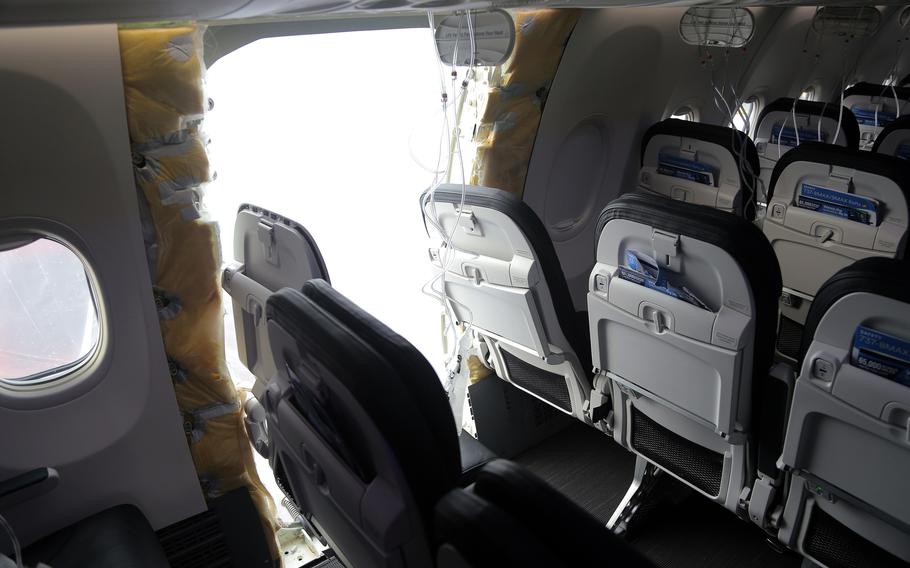
A door-sized section near the rear of the Boeing 737-9 MAX plane blew off 10 minutes after Alaska Airlines Flight 1282 took off from Portland, Ore., on Jan. 5, 2024, on its way to Ontario, Calif. (National Transportation Safety Board)
Boeing’s troubles keep mounting. Already facing renewed fears about the safety of its 737 MAX commercial aircraft, the company is now grappling with allegations from a new whistleblower, quality engineer Sam Salehpour. A Senate subcommittee has subpoenaed CEO David Calhoun to respond.
The key issue at Boeing is not just about whether adequate safety precautions are being taken. It’s about the culture of the entire organization.
The New York Times reported that Salehpour “said he was repeatedly retaliated against for raising concerns about shortcuts he believed that Boeing was taking in joining together the pieces of the Dreamliner’s fuselage.” Boeing says it is “fully confident” in the 787 and that concerns about structural integrity are “inaccurate,” The Associated Press reports.
But Salehpour’s descriptions fit right in with something that has troubled the company for years: what a Government Accountability Project columnist called a “culture of secrecy and intimidation.”
In the wake of two fatal crashes in 2018 and 2019, the Federal Aviation Administration and Congress launched investigations. Boeing employees described a company filled with distrust, concealment of problems, and fear of reprisals that left employees too scared to speak up.
This year, after the January fuselage blowout involving a door panel on an Alaska Airlines jet, the FAA issued a new, scathing report about the company’s safety culture. Meanwhile there have been new incidents, including one Sunday in which the engine cover of a Boeing 737-800 came off and hit the wing, leading to an emergency landing.
Boeing must finally do the hard work of transforming its culture. It’s similar to the shift that my team and I have been helping parts of the military to enact: a new mindset driven by curiosity and the excitement for new possibilities rather than fear of failure or the instinct to place blame.
The risks of a ‘no fail’ culture
To be fair, based on our observations, things are not this bad in the military. But two powerful ingredients in military culture often combine to cause problems. First, unwavering enforcement of hierarchies leaves nearly everyone afraid to speak up. And second, the frequent talk of “no fail” missions creates cognitive dissonance because mistakes are inevitable but never tolerated.
Take, for example, the ProPublica story about how littoral combat ships became “one of the worst boondoggles in the military’s long history of buying overpriced and underperforming weapons.” Sailors knew there were problems with these ships. But as the day to showcase one in a naval exercise approached, “pressure mounted,” with top officers visiting repeatedly. The sailors “understood that theirs was a ‘no fail mission.’” Days after the ship returned to port, a maintenance check showed “galloping corrosion” of an engine. A sailor described the engine room as “a horror show.” Fear — of both speaking up and challenging superiors — had led people to look away from serious problems.
Similar issues contributed to the missileers scandal, in which officers responsible for nuclear missiles were caught cheating on proficiency tests or not reporting the cheating. More than 90 were implicated. Reports cited a culture of stress, fear and perfectionism.
Redesigning cultural norms
All workplaces, both civilian and military, operate based on cultural norms that are drilled into people’s minds through daily actions. Changing a work culture — achieving real human transformation — requires actively altering those norms.
This can be done without giving up demands for excellence. Leaders need to make clear that “no fail” does not mean “never admit mistakes” or “cover up wrongdoing.” Instead, they should focus on the importance of gathering and providing as much information as possible in order to make the best decisions. There will always be things that go wrong. When that happens, the reflexive response should not be to find someone to blame; it should be to unpack the root causes and correct them.
When my team began working with the 412th Test Wing at Edwards Air Force Base, Calif., to help spark a culture of innovation, some early feedback from personnel was, “We are not sure what we are allowed to do to challenge the status quo.” Many also asked what the reward system was for being innovative and suggesting new, better ways of doing things. They had never seen evidence of rewards for this.
Through substantive changes and use of semiotics — signs and symbols that communicate ideas — we saw innovation levels take off. E. John Teichert, a retired U.S. Air Force brigadier general who is running for U.S. Senate in Maryland, soon joined our team. We’re also working with the Defense Department’s Data Analytics and A.I. Adoption Strategy to create similar culture change. Little by little, things are improving. Still, across the services, there’s a long way to go. To win the “great power competition,” the military needs to speed up this transformation.
We coach our clients to understand that culture is to people as software is to computers. Culture defines how people operate, day to day, inside any organization. It does not simply appear based on promises or lofty statements; it takes programming to restructure an organizational ethos. Both Boeing and the military accomplish amazing things. They can accomplish this, too.
Jason Korman is CEO of Gapingvoid Culture Design Group.